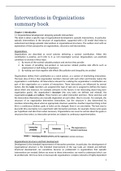Summary
Summary book 'Organizational development: designing episodic interventions'
- Course
- Institution
- Book
Summary of the book 'Organizational development: designing episodic interventions' from Jan Achterbergh and Dirk Vriens. The summary is quite big, but it contains all examples, figures and tables needed for the exam. The book itself is 350 pages.
[Show more]




